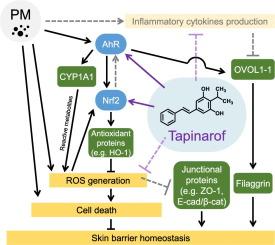天然二苯乙烯类植物tapinarof可双重激活AhR和Nrf2通路,防止颗粒物质引起的皮肤屏障功能障碍。
IF 3.4
3区 医学
Q2 PHARMACOLOGY & PHARMACY
引用次数: 0
摘要
颗粒物(PM)通过诱导活性氧(ROS)过量产生和氧化应激导致皮肤屏障功能障碍。芳烃受体(AhR)和核因子红系2相关因子(Nrf2)分别协调异种代谢和抗氧化防御,在细胞保护中起关键作用。本研究旨在探讨双激活AhR和Nrf2通路的天然二苯乙烯类化合物tapinarof对pm诱导的表皮损伤的治疗潜力。将人角质细胞HaCaT细胞暴露于城市粉尘PM (NIST®SRM®1649b)中,以模拟PM诱导的表皮损伤。开发了一种基于图像的分析算法,消除PM荧光干扰,促使使用替代波长专门分析PM诱导的细胞反应。Tapinarof增强pm诱导的CYP1A1和HO-1表达,证实AhR/Nrf2激活。AhR拮抗剂CH223191和Nrf2抑制剂brusatol证实,这种双途径激活保护细胞免受pm诱导的氧化应激和细胞死亡。共聚焦成像和免疫印迹显示,木薯粉通过恢复紧密连接蛋白ZO-1和粘附连接复合体E-cadherin/β-catenin的脱位和维持角化包膜蛋白聚丝蛋白的表达来保护pm损伤的表皮屏障完整性。AhR/Nrf2通路的双重激活有效地防止pm诱导的表皮屏障功能障碍,突出了天然衍生的双重AhR/Nrf2激活剂如tapinarof对环境皮肤损伤的治疗潜力。本文章由计算机程序翻译,如有差异,请以英文原文为准。

Dual activation of AhR and Nrf2 pathways by the natural stilbenoid tapinarof protects against particulate matter-induced skin barrier dysfunction
Particulate matter (PM) causes skin barrier dysfunction by inducing reactive oxygen species (ROS) overproduction and oxidative stress. The aryl hydrocarbon receptor (AhR) and nuclear factor erythroid 2-related factor (Nrf2) coordinate xenobiotic metabolism and antioxidant defense, respectively, playing key roles in cytoprotection. This study aimed to investigate the therapeutic potential of tapinarof, a natural stilbenoid dually activating AhR and Nrf2 pathways, against PM-induced epidermal damage. Human keratinocyte HaCaT cells were exposed to urban dust PM (NIST® SRM® 1649b) to model PM-induced epidermal damage. An image-based analysis algorithm that eliminates PM fluorescence interference was developed, prompting the use of alternative wavelengths for specifically analyzing PM-induced cellular responses. Tapinarof potentiated PM-induced CYP1A1 and HO-1 expression, confirming AhR/Nrf2 activation. This dual pathway activation protected cells from PM-induced oxidative stress and cell death, as validated using the AhR antagonist, CH223191, and Nrf2 inhibitor, brusatol. Confocal imaging and immunoblotting suggested that tapinarof preserved PM-damaged epidermal barrier integrity by restoring the delocalization of tight junction protein ZO-1 and adherens junction complex E-cadherin/β-catenin and maintaining expressions of cornified envelope protein filaggrin. Dual activation of AhR/Nrf2 pathways effectively protects against PM-induced epidermal barrier dysfunction, highlighting the therapeutic potential of naturally derived dual AhR/Nrf2 activators like tapinarof against environmental skin damage.
求助全文
通过发布文献求助,成功后即可免费获取论文全文。
去求助
来源期刊
CiteScore
6.80
自引率
2.60%
发文量
309
审稿时长
32 days
期刊介绍:
Toxicology and Applied Pharmacology publishes original scientific research of relevance to animals or humans pertaining to the action of chemicals, drugs, or chemically-defined natural products.
Regular articles address mechanistic approaches to physiological, pharmacologic, biochemical, cellular, or molecular understanding of toxicologic/pathologic lesions and to methods used to describe these responses. Safety Science articles address outstanding state-of-the-art preclinical and human translational characterization of drug and chemical safety employing cutting-edge science. Highly significant Regulatory Safety Science articles will also be considered in this category. Papers concerned with alternatives to the use of experimental animals are encouraged.
Short articles report on high impact studies of broad interest to readers of TAAP that would benefit from rapid publication. These articles should contain no more than a combined total of four figures and tables. Authors should include in their cover letter the justification for consideration of their manuscript as a short article.

 求助内容:
求助内容: 应助结果提醒方式:
应助结果提醒方式:


